James Grice Critical Review: Domestic Violence in Australia
VerifiedAdded on 2022/09/23
|9
|2127
|36
Report
AI Summary
This report presents a critical review of domestic violence in Australia from a sociological perspective. It examines the increasing prevalence of domestic violence, the factors contributing to it, and the impact on victims, including men, women, and children. The report analyzes various research articles, including studies on social determinants of intimate partner violence, the effects of federal structures on policy-making, the experiences of child witnesses, and the challenges faced by victims in discussing their experiences. It also considers the role of law enforcement, legislative reforms, and strategies to combat domestic violence through awareness, education, and strong policies. The review highlights the need for a comprehensive approach that addresses the root causes of violence and provides support for victims while emphasizing the importance of economic stability, awareness programs, and the empowerment of women. The report concludes with a call for improved law enforcement, responsive support systems, and effective policy-making to protect citizens and reduce domestic violence.
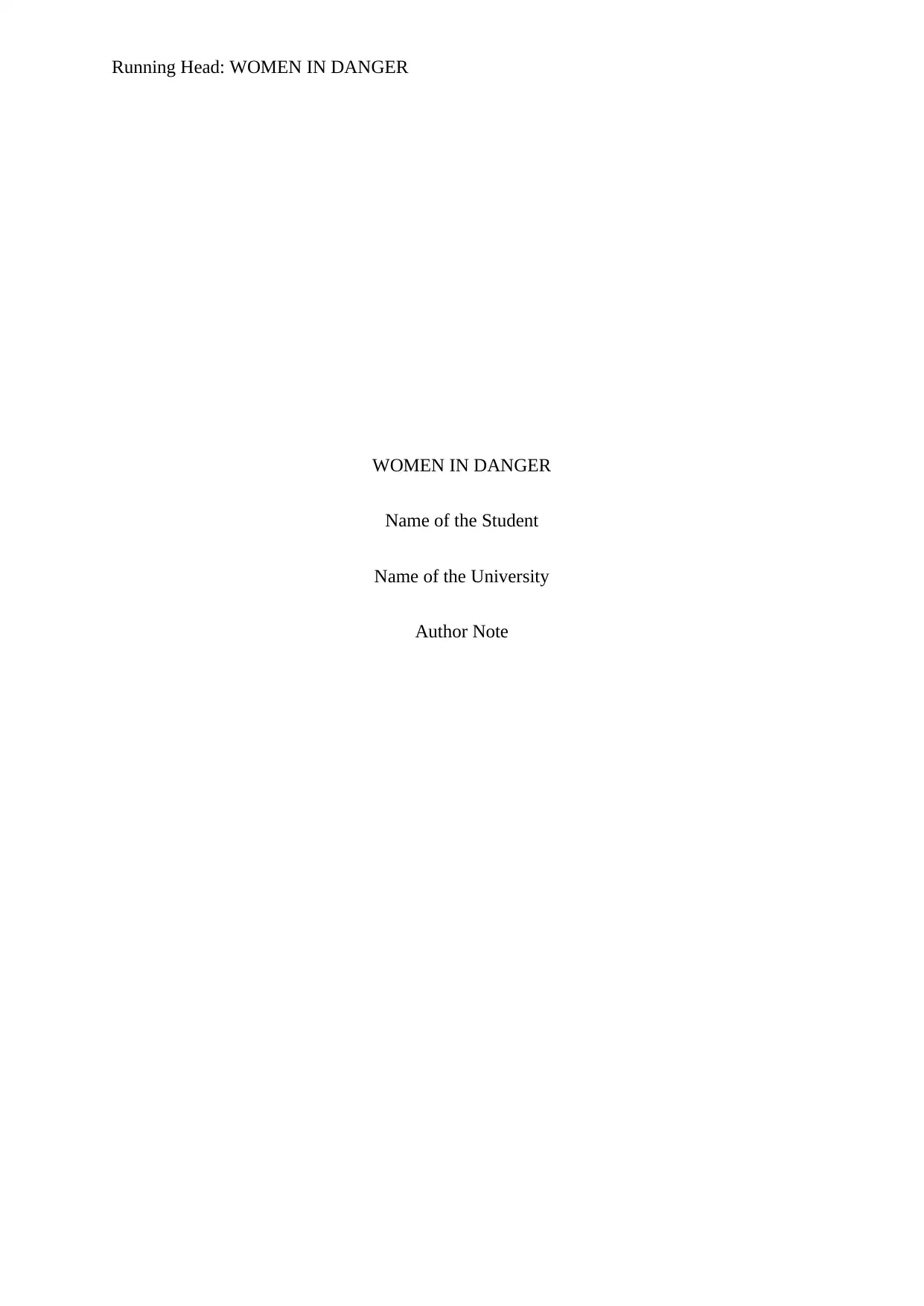
Running Head: WOMEN IN DANGER
WOMEN IN DANGER
Name of the Student
Name of the University
Author Note
WOMEN IN DANGER
Name of the Student
Name of the University
Author Note
Paraphrase This Document
Need a fresh take? Get an instant paraphrase of this document with our AI Paraphraser
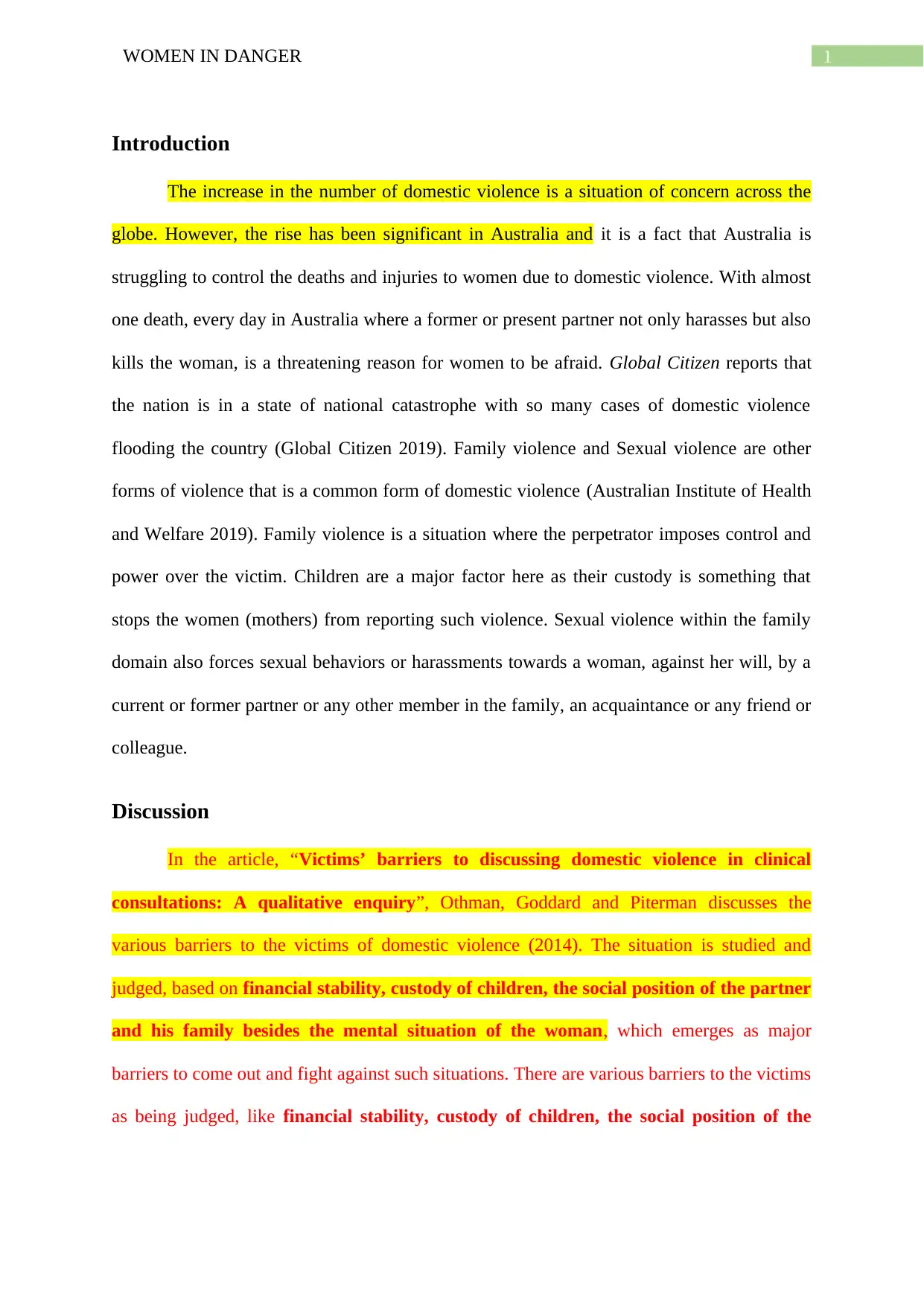
1WOMEN IN DANGER
Introduction
The increase in the number of domestic violence is a situation of concern across the
globe. However, the rise has been significant in Australia and it is a fact that Australia is
struggling to control the deaths and injuries to women due to domestic violence. With almost
one death, every day in Australia where a former or present partner not only harasses but also
kills the woman, is a threatening reason for women to be afraid. Global Citizen reports that
the nation is in a state of national catastrophe with so many cases of domestic violence
flooding the country (Global Citizen 2019). Family violence and Sexual violence are other
forms of violence that is a common form of domestic violence (Australian Institute of Health
and Welfare 2019). Family violence is a situation where the perpetrator imposes control and
power over the victim. Children are a major factor here as their custody is something that
stops the women (mothers) from reporting such violence. Sexual violence within the family
domain also forces sexual behaviors or harassments towards a woman, against her will, by a
current or former partner or any other member in the family, an acquaintance or any friend or
colleague.
Discussion
In the article, “Victims’ barriers to discussing domestic violence in clinical
consultations: A qualitative enquiry”, Othman, Goddard and Piterman discusses the
various barriers to the victims of domestic violence (2014). The situation is studied and
judged, based on financial stability, custody of children, the social position of the partner
and his family besides the mental situation of the woman, which emerges as major
barriers to come out and fight against such situations. There are various barriers to the victims
as being judged, like financial stability, custody of children, the social position of the
Introduction
The increase in the number of domestic violence is a situation of concern across the
globe. However, the rise has been significant in Australia and it is a fact that Australia is
struggling to control the deaths and injuries to women due to domestic violence. With almost
one death, every day in Australia where a former or present partner not only harasses but also
kills the woman, is a threatening reason for women to be afraid. Global Citizen reports that
the nation is in a state of national catastrophe with so many cases of domestic violence
flooding the country (Global Citizen 2019). Family violence and Sexual violence are other
forms of violence that is a common form of domestic violence (Australian Institute of Health
and Welfare 2019). Family violence is a situation where the perpetrator imposes control and
power over the victim. Children are a major factor here as their custody is something that
stops the women (mothers) from reporting such violence. Sexual violence within the family
domain also forces sexual behaviors or harassments towards a woman, against her will, by a
current or former partner or any other member in the family, an acquaintance or any friend or
colleague.
Discussion
In the article, “Victims’ barriers to discussing domestic violence in clinical
consultations: A qualitative enquiry”, Othman, Goddard and Piterman discusses the
various barriers to the victims of domestic violence (2014). The situation is studied and
judged, based on financial stability, custody of children, the social position of the partner
and his family besides the mental situation of the woman, which emerges as major
barriers to come out and fight against such situations. There are various barriers to the victims
as being judged, like financial stability, custody of children, the social position of the
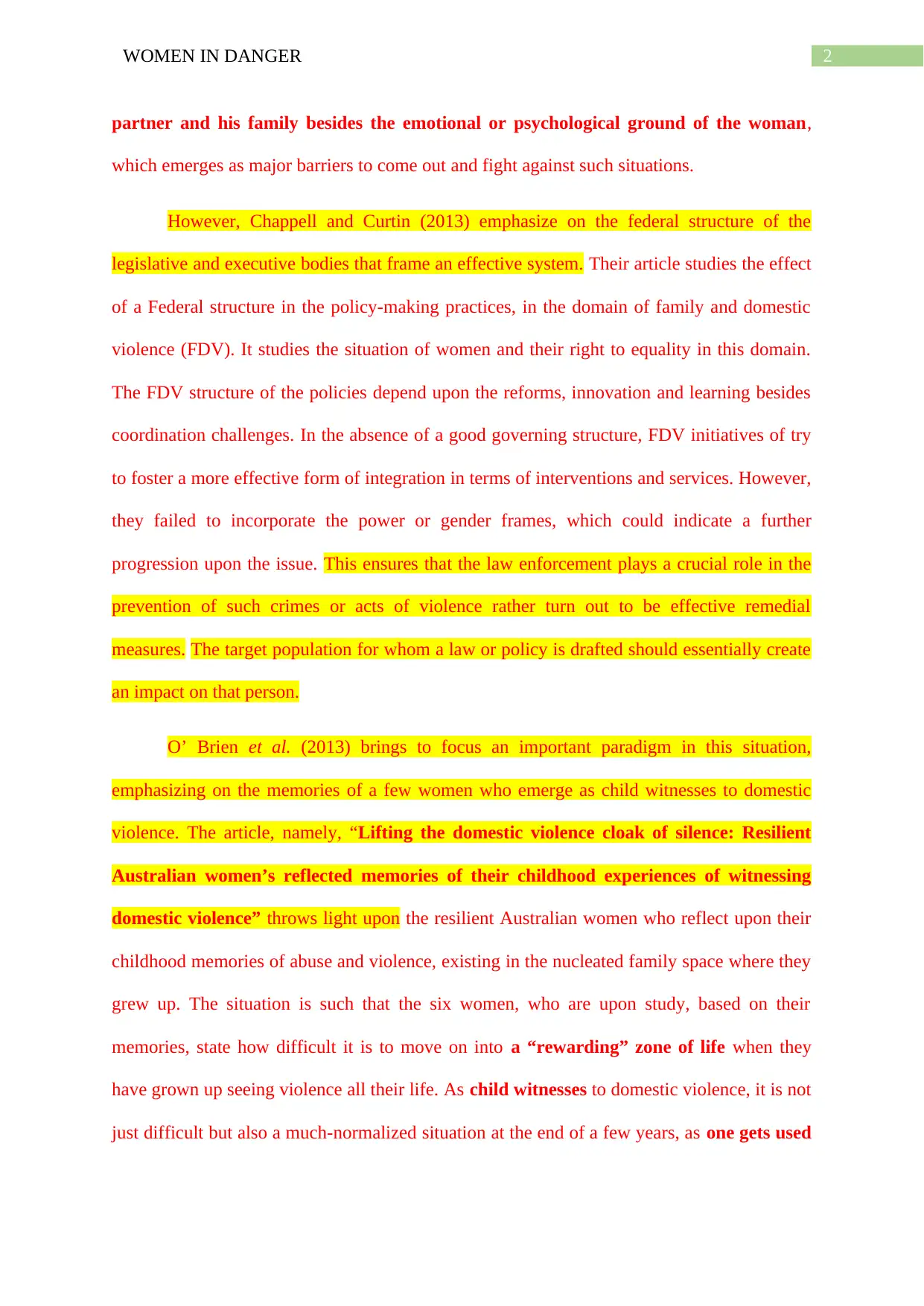
2WOMEN IN DANGER
partner and his family besides the emotional or psychological ground of the woman,
which emerges as major barriers to come out and fight against such situations.
However, Chappell and Curtin (2013) emphasize on the federal structure of the
legislative and executive bodies that frame an effective system. Their article studies the effect
of a Federal structure in the policy-making practices, in the domain of family and domestic
violence (FDV). It studies the situation of women and their right to equality in this domain.
The FDV structure of the policies depend upon the reforms, innovation and learning besides
coordination challenges. In the absence of a good governing structure, FDV initiatives of try
to foster a more effective form of integration in terms of interventions and services. However,
they failed to incorporate the power or gender frames, which could indicate a further
progression upon the issue. This ensures that the law enforcement plays a crucial role in the
prevention of such crimes or acts of violence rather turn out to be effective remedial
measures. The target population for whom a law or policy is drafted should essentially create
an impact on that person.
O’ Brien et al. (2013) brings to focus an important paradigm in this situation,
emphasizing on the memories of a few women who emerge as child witnesses to domestic
violence. The article, namely, “Lifting the domestic violence cloak of silence: Resilient
Australian women’s reflected memories of their childhood experiences of witnessing
domestic violence” throws light upon the resilient Australian women who reflect upon their
childhood memories of abuse and violence, existing in the nucleated family space where they
grew up. The situation is such that the six women, who are upon study, based on their
memories, state how difficult it is to move on into a “rewarding” zone of life when they
have grown up seeing violence all their life. As child witnesses to domestic violence, it is not
just difficult but also a much-normalized situation at the end of a few years, as one gets used
partner and his family besides the emotional or psychological ground of the woman,
which emerges as major barriers to come out and fight against such situations.
However, Chappell and Curtin (2013) emphasize on the federal structure of the
legislative and executive bodies that frame an effective system. Their article studies the effect
of a Federal structure in the policy-making practices, in the domain of family and domestic
violence (FDV). It studies the situation of women and their right to equality in this domain.
The FDV structure of the policies depend upon the reforms, innovation and learning besides
coordination challenges. In the absence of a good governing structure, FDV initiatives of try
to foster a more effective form of integration in terms of interventions and services. However,
they failed to incorporate the power or gender frames, which could indicate a further
progression upon the issue. This ensures that the law enforcement plays a crucial role in the
prevention of such crimes or acts of violence rather turn out to be effective remedial
measures. The target population for whom a law or policy is drafted should essentially create
an impact on that person.
O’ Brien et al. (2013) brings to focus an important paradigm in this situation,
emphasizing on the memories of a few women who emerge as child witnesses to domestic
violence. The article, namely, “Lifting the domestic violence cloak of silence: Resilient
Australian women’s reflected memories of their childhood experiences of witnessing
domestic violence” throws light upon the resilient Australian women who reflect upon their
childhood memories of abuse and violence, existing in the nucleated family space where they
grew up. The situation is such that the six women, who are upon study, based on their
memories, state how difficult it is to move on into a “rewarding” zone of life when they
have grown up seeing violence all their life. As child witnesses to domestic violence, it is not
just difficult but also a much-normalized situation at the end of a few years, as one gets used
⊘ This is a preview!⊘
Do you want full access?
Subscribe today to unlock all pages.

Trusted by 1+ million students worldwide
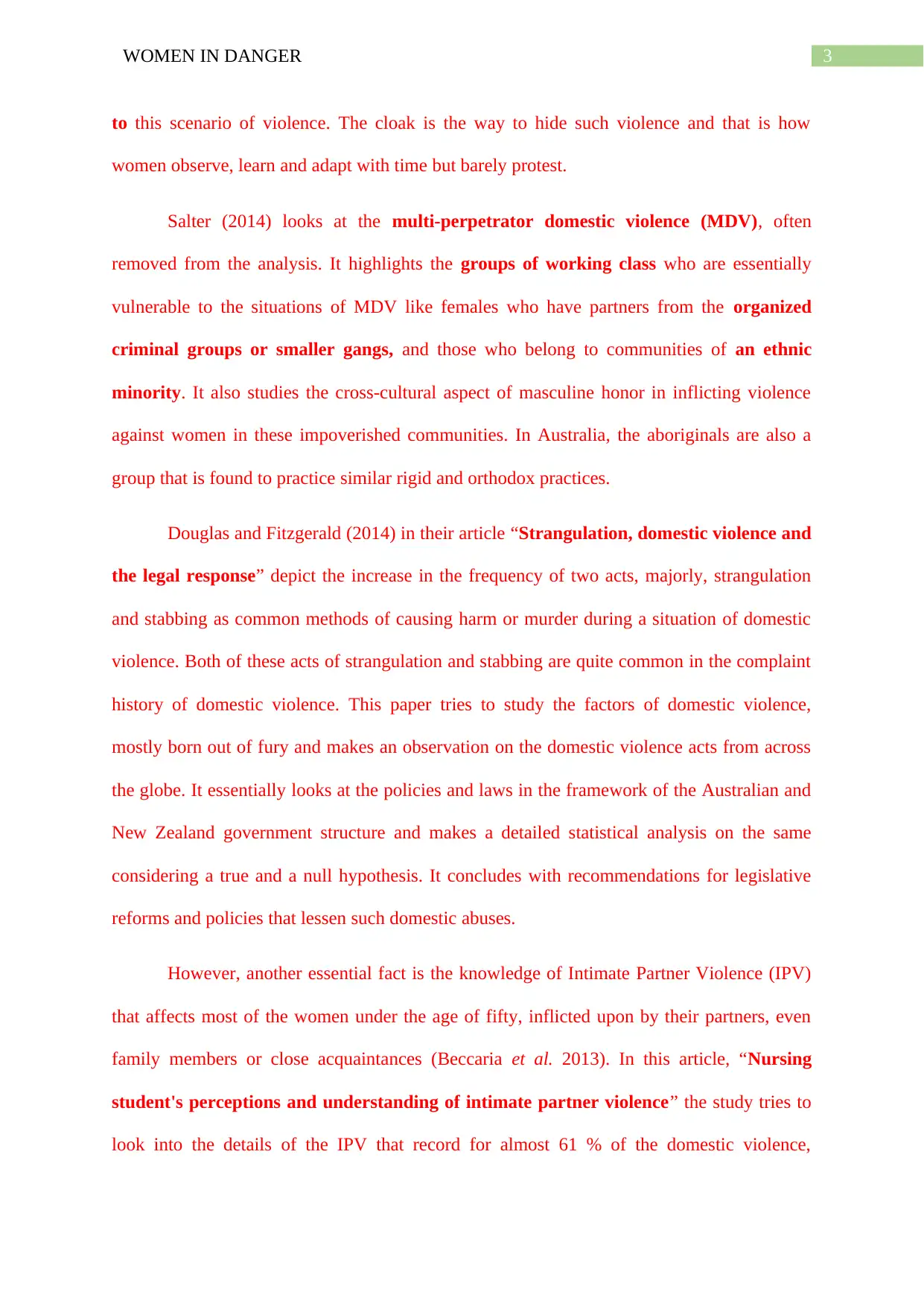
3WOMEN IN DANGER
to this scenario of violence. The cloak is the way to hide such violence and that is how
women observe, learn and adapt with time but barely protest.
Salter (2014) looks at the multi-perpetrator domestic violence (MDV), often
removed from the analysis. It highlights the groups of working class who are essentially
vulnerable to the situations of MDV like females who have partners from the organized
criminal groups or smaller gangs, and those who belong to communities of an ethnic
minority. It also studies the cross-cultural aspect of masculine honor in inflicting violence
against women in these impoverished communities. In Australia, the aboriginals are also a
group that is found to practice similar rigid and orthodox practices.
Douglas and Fitzgerald (2014) in their article “Strangulation, domestic violence and
the legal response” depict the increase in the frequency of two acts, majorly, strangulation
and stabbing as common methods of causing harm or murder during a situation of domestic
violence. Both of these acts of strangulation and stabbing are quite common in the complaint
history of domestic violence. This paper tries to study the factors of domestic violence,
mostly born out of fury and makes an observation on the domestic violence acts from across
the globe. It essentially looks at the policies and laws in the framework of the Australian and
New Zealand government structure and makes a detailed statistical analysis on the same
considering a true and a null hypothesis. It concludes with recommendations for legislative
reforms and policies that lessen such domestic abuses.
However, another essential fact is the knowledge of Intimate Partner Violence (IPV)
that affects most of the women under the age of fifty, inflicted upon by their partners, even
family members or close acquaintances (Beccaria et al. 2013). In this article, “Nursing
student's perceptions and understanding of intimate partner violence” the study tries to
look into the details of the IPV that record for almost 61 % of the domestic violence,
to this scenario of violence. The cloak is the way to hide such violence and that is how
women observe, learn and adapt with time but barely protest.
Salter (2014) looks at the multi-perpetrator domestic violence (MDV), often
removed from the analysis. It highlights the groups of working class who are essentially
vulnerable to the situations of MDV like females who have partners from the organized
criminal groups or smaller gangs, and those who belong to communities of an ethnic
minority. It also studies the cross-cultural aspect of masculine honor in inflicting violence
against women in these impoverished communities. In Australia, the aboriginals are also a
group that is found to practice similar rigid and orthodox practices.
Douglas and Fitzgerald (2014) in their article “Strangulation, domestic violence and
the legal response” depict the increase in the frequency of two acts, majorly, strangulation
and stabbing as common methods of causing harm or murder during a situation of domestic
violence. Both of these acts of strangulation and stabbing are quite common in the complaint
history of domestic violence. This paper tries to study the factors of domestic violence,
mostly born out of fury and makes an observation on the domestic violence acts from across
the globe. It essentially looks at the policies and laws in the framework of the Australian and
New Zealand government structure and makes a detailed statistical analysis on the same
considering a true and a null hypothesis. It concludes with recommendations for legislative
reforms and policies that lessen such domestic abuses.
However, another essential fact is the knowledge of Intimate Partner Violence (IPV)
that affects most of the women under the age of fifty, inflicted upon by their partners, even
family members or close acquaintances (Beccaria et al. 2013). In this article, “Nursing
student's perceptions and understanding of intimate partner violence” the study tries to
look into the details of the IPV that record for almost 61 % of the domestic violence,
Paraphrase This Document
Need a fresh take? Get an instant paraphrase of this document with our AI Paraphraser
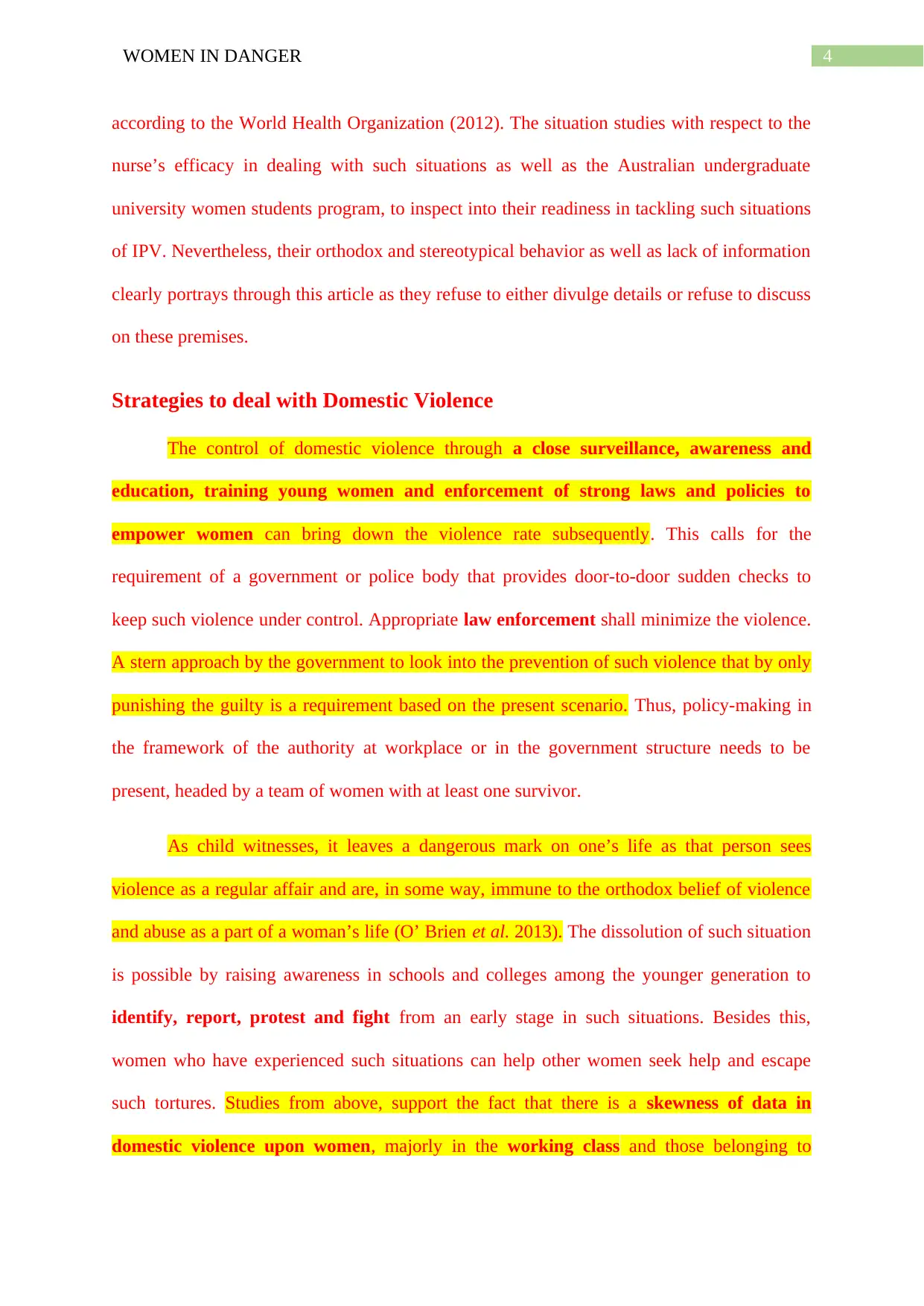
4WOMEN IN DANGER
according to the World Health Organization (2012). The situation studies with respect to the
nurse’s efficacy in dealing with such situations as well as the Australian undergraduate
university women students program, to inspect into their readiness in tackling such situations
of IPV. Nevertheless, their orthodox and stereotypical behavior as well as lack of information
clearly portrays through this article as they refuse to either divulge details or refuse to discuss
on these premises.
Strategies to deal with Domestic Violence
The control of domestic violence through a close surveillance, awareness and
education, training young women and enforcement of strong laws and policies to
empower women can bring down the violence rate subsequently. This calls for the
requirement of a government or police body that provides door-to-door sudden checks to
keep such violence under control. Appropriate law enforcement shall minimize the violence.
A stern approach by the government to look into the prevention of such violence that by only
punishing the guilty is a requirement based on the present scenario. Thus, policy-making in
the framework of the authority at workplace or in the government structure needs to be
present, headed by a team of women with at least one survivor.
As child witnesses, it leaves a dangerous mark on one’s life as that person sees
violence as a regular affair and are, in some way, immune to the orthodox belief of violence
and abuse as a part of a woman’s life (O’ Brien et al. 2013). The dissolution of such situation
is possible by raising awareness in schools and colleges among the younger generation to
identify, report, protest and fight from an early stage in such situations. Besides this,
women who have experienced such situations can help other women seek help and escape
such tortures. Studies from above, support the fact that there is a skewness of data in
domestic violence upon women, majorly in the working class and those belonging to
according to the World Health Organization (2012). The situation studies with respect to the
nurse’s efficacy in dealing with such situations as well as the Australian undergraduate
university women students program, to inspect into their readiness in tackling such situations
of IPV. Nevertheless, their orthodox and stereotypical behavior as well as lack of information
clearly portrays through this article as they refuse to either divulge details or refuse to discuss
on these premises.
Strategies to deal with Domestic Violence
The control of domestic violence through a close surveillance, awareness and
education, training young women and enforcement of strong laws and policies to
empower women can bring down the violence rate subsequently. This calls for the
requirement of a government or police body that provides door-to-door sudden checks to
keep such violence under control. Appropriate law enforcement shall minimize the violence.
A stern approach by the government to look into the prevention of such violence that by only
punishing the guilty is a requirement based on the present scenario. Thus, policy-making in
the framework of the authority at workplace or in the government structure needs to be
present, headed by a team of women with at least one survivor.
As child witnesses, it leaves a dangerous mark on one’s life as that person sees
violence as a regular affair and are, in some way, immune to the orthodox belief of violence
and abuse as a part of a woman’s life (O’ Brien et al. 2013). The dissolution of such situation
is possible by raising awareness in schools and colleges among the younger generation to
identify, report, protest and fight from an early stage in such situations. Besides this,
women who have experienced such situations can help other women seek help and escape
such tortures. Studies from above, support the fact that there is a skewness of data in
domestic violence upon women, majorly in the working class and those belonging to

5WOMEN IN DANGER
minorities with impoverished or criminal living backgrounds (Salter 2014). This
community lacks necessities and requires proper education and awareness. Police raids in the
areas close to the underbelly or identified as such an impoverished zone can improvise the
situations. Women can be empowered through smaller government programs in such
situations so that they do not need to depend on their husbands or in-laws for the upkeep of
their children or their own selves.
An economic stability besides a liberal way of thinking is essential for minimizing
the domestic violence and attaining a satisfied and happier family life. Control of fury and
rationalizing one’s thoughts are essential. The fast moving lifestyle, captured in the gadgets,
barely allows time for the self or relaxation. This is essential to keep the hormones in control
besides reducing frustration from work life or insecurities in the relationships. Therefore, a
requirement of sufficient awareness programs and trainings among women across ages,
and communities, especially targeting those in colleges are ideal situations to transform and
develop these women into stronger individuals who can protest for their own selves (Beccaria
et al. 2013).
Conclusion
In the year 2018, magazines and reports showed a large number of crime on domestic
violence. This was turning the nation into a hostile ground, unable to protect its own women
citizens. In addition, a person who fears any kind of domestic violence can apply for civil
protection orders. However, many people have complained against the same, citing the
helpline numbers remaining inactive or unresponsive in situations of urgency. The law and
justice system also seems flawed, as, in most of the cases, discussed above; the punishment is
not sufficient considering the life-threatening experience that the victim has undergone. This
is both traumatic and needs efficient surveillance of the police and the law.
minorities with impoverished or criminal living backgrounds (Salter 2014). This
community lacks necessities and requires proper education and awareness. Police raids in the
areas close to the underbelly or identified as such an impoverished zone can improvise the
situations. Women can be empowered through smaller government programs in such
situations so that they do not need to depend on their husbands or in-laws for the upkeep of
their children or their own selves.
An economic stability besides a liberal way of thinking is essential for minimizing
the domestic violence and attaining a satisfied and happier family life. Control of fury and
rationalizing one’s thoughts are essential. The fast moving lifestyle, captured in the gadgets,
barely allows time for the self or relaxation. This is essential to keep the hormones in control
besides reducing frustration from work life or insecurities in the relationships. Therefore, a
requirement of sufficient awareness programs and trainings among women across ages,
and communities, especially targeting those in colleges are ideal situations to transform and
develop these women into stronger individuals who can protest for their own selves (Beccaria
et al. 2013).
Conclusion
In the year 2018, magazines and reports showed a large number of crime on domestic
violence. This was turning the nation into a hostile ground, unable to protect its own women
citizens. In addition, a person who fears any kind of domestic violence can apply for civil
protection orders. However, many people have complained against the same, citing the
helpline numbers remaining inactive or unresponsive in situations of urgency. The law and
justice system also seems flawed, as, in most of the cases, discussed above; the punishment is
not sufficient considering the life-threatening experience that the victim has undergone. This
is both traumatic and needs efficient surveillance of the police and the law.
⊘ This is a preview!⊘
Do you want full access?
Subscribe today to unlock all pages.

Trusted by 1+ million students worldwide

6WOMEN IN DANGER
Paraphrase This Document
Need a fresh take? Get an instant paraphrase of this document with our AI Paraphraser
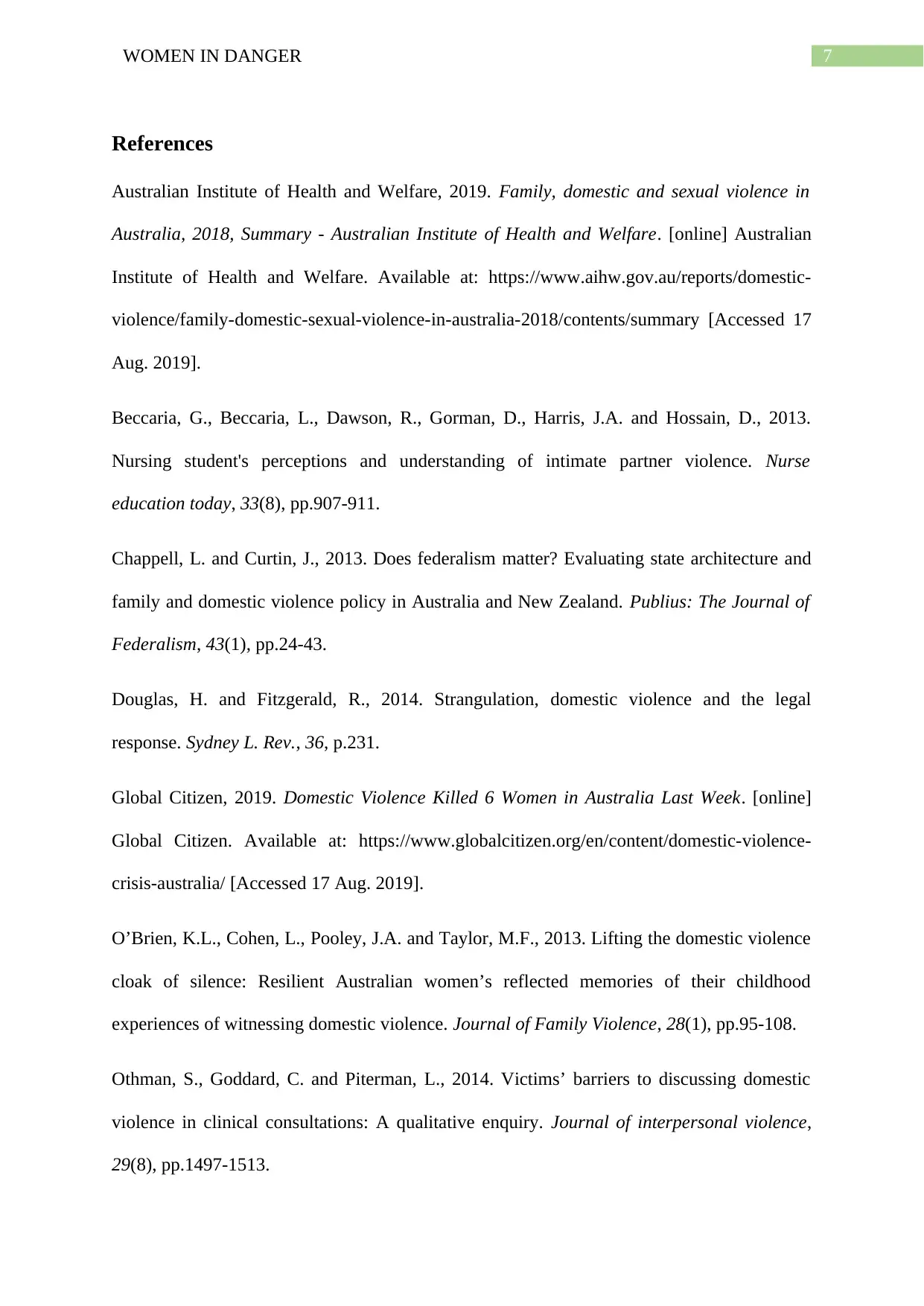
7WOMEN IN DANGER
References
Australian Institute of Health and Welfare, 2019. Family, domestic and sexual violence in
Australia, 2018, Summary - Australian Institute of Health and Welfare. [online] Australian
Institute of Health and Welfare. Available at: https://www.aihw.gov.au/reports/domestic-
violence/family-domestic-sexual-violence-in-australia-2018/contents/summary [Accessed 17
Aug. 2019].
Beccaria, G., Beccaria, L., Dawson, R., Gorman, D., Harris, J.A. and Hossain, D., 2013.
Nursing student's perceptions and understanding of intimate partner violence. Nurse
education today, 33(8), pp.907-911.
Chappell, L. and Curtin, J., 2013. Does federalism matter? Evaluating state architecture and
family and domestic violence policy in Australia and New Zealand. Publius: The Journal of
Federalism, 43(1), pp.24-43.
Douglas, H. and Fitzgerald, R., 2014. Strangulation, domestic violence and the legal
response. Sydney L. Rev., 36, p.231.
Global Citizen, 2019. Domestic Violence Killed 6 Women in Australia Last Week. [online]
Global Citizen. Available at: https://www.globalcitizen.org/en/content/domestic-violence-
crisis-australia/ [Accessed 17 Aug. 2019].
O’Brien, K.L., Cohen, L., Pooley, J.A. and Taylor, M.F., 2013. Lifting the domestic violence
cloak of silence: Resilient Australian women’s reflected memories of their childhood
experiences of witnessing domestic violence. Journal of Family Violence, 28(1), pp.95-108.
Othman, S., Goddard, C. and Piterman, L., 2014. Victims’ barriers to discussing domestic
violence in clinical consultations: A qualitative enquiry. Journal of interpersonal violence,
29(8), pp.1497-1513.
References
Australian Institute of Health and Welfare, 2019. Family, domestic and sexual violence in
Australia, 2018, Summary - Australian Institute of Health and Welfare. [online] Australian
Institute of Health and Welfare. Available at: https://www.aihw.gov.au/reports/domestic-
violence/family-domestic-sexual-violence-in-australia-2018/contents/summary [Accessed 17
Aug. 2019].
Beccaria, G., Beccaria, L., Dawson, R., Gorman, D., Harris, J.A. and Hossain, D., 2013.
Nursing student's perceptions and understanding of intimate partner violence. Nurse
education today, 33(8), pp.907-911.
Chappell, L. and Curtin, J., 2013. Does federalism matter? Evaluating state architecture and
family and domestic violence policy in Australia and New Zealand. Publius: The Journal of
Federalism, 43(1), pp.24-43.
Douglas, H. and Fitzgerald, R., 2014. Strangulation, domestic violence and the legal
response. Sydney L. Rev., 36, p.231.
Global Citizen, 2019. Domestic Violence Killed 6 Women in Australia Last Week. [online]
Global Citizen. Available at: https://www.globalcitizen.org/en/content/domestic-violence-
crisis-australia/ [Accessed 17 Aug. 2019].
O’Brien, K.L., Cohen, L., Pooley, J.A. and Taylor, M.F., 2013. Lifting the domestic violence
cloak of silence: Resilient Australian women’s reflected memories of their childhood
experiences of witnessing domestic violence. Journal of Family Violence, 28(1), pp.95-108.
Othman, S., Goddard, C. and Piterman, L., 2014. Victims’ barriers to discussing domestic
violence in clinical consultations: A qualitative enquiry. Journal of interpersonal violence,
29(8), pp.1497-1513.

8WOMEN IN DANGER
Salter, M., 2014. Multi-perpetrator domestic violence. Trauma, Violence, & Abuse, 15(2),
pp.102-112.
Salter, M., 2014. Multi-perpetrator domestic violence. Trauma, Violence, & Abuse, 15(2),
pp.102-112.
⊘ This is a preview!⊘
Do you want full access?
Subscribe today to unlock all pages.

Trusted by 1+ million students worldwide
1 out of 9
Related Documents
Your All-in-One AI-Powered Toolkit for Academic Success.
+13062052269
info@desklib.com
Available 24*7 on WhatsApp / Email
![[object Object]](/_next/static/media/star-bottom.7253800d.svg)
Unlock your academic potential
Copyright © 2020–2025 A2Z Services. All Rights Reserved. Developed and managed by ZUCOL.





